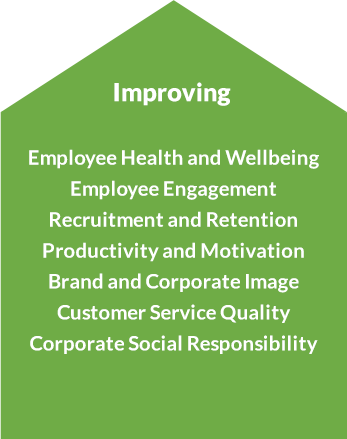
There are so many good reasons to have an employee wellbeing programme in your organisation.
- Employee health and wellbeing – over the course of three years, one of our clients found that amongst staff who attended at least two onsite health checks, 80% improved their cholesterol levels. By raising awareness and improving understanding of key health risks and encouraging individuals to make healthy lifestyle choices, you’ll be helping your workforce to sustain and improve their health and wellbeing and encouraging them to take individual responsibility for their health.
- Employee engagement – an employee wellbeing strategy is an effective way of improving motivation, performance, satisfaction, discretionary effort and overall engagement.
- Recruitment – wellbeing strategy can be an important element in the overall benefits package that potential employees consider when deciding who to work for.
- Staff retention – as with the above, wellbeing is an important part of an employee’s package and has a huge part to play in encouraging them to stay put. The cost savings to your organisation can be huge. A financial services client of ours estimated that by reducing staff turnover by 9%, they have achieved cost savings of over £1.6m since implementing their wellbeing programme. The average cost to replace a leaver can be £30,614.
- Reduced sickness absence – there are various statistics relating to the cost of sickness absence but according to the Confederation of British Industry (CBI), it can cost an average of £495 per employee per year. Recent statistics for average sickness days from Chartered Institute of Personnel and Development (CIPD) suggest that 6.3 days are lost per annum per employee with an average annual cost per employee of £522. By offering onsite health checks, you can help staff to identify issues early and reduce the instances of sickness absence. From the thousands of health checks we’ve carried out over the years, we’ve found that on average, 1 in 4 employees could have high blood pressure. If you can identify health risks such as this in your organisation, you can help to address them early to the benefit of everyone.
- Reduced workplace accidents and injury – the average cost to employees of workplace injury and illness is £2.8bn (British Heart Foundation, Health at Work Economic Evidence Report 2016). With improved fitness levels, less fatigue and increased reaction times, employees are less likely to be at risk of injury.
- Organisational productivity – it is thought an unhealthy employee is 20% less productive and twice as prone to illness than a healthy colleague – this is equivalent to one day a week. With improved health and wellbeing, individuals are more motivated, teams perform better and the business bottom-line improves.
- Brand reputation, corporate image and social responsibility – having a wellbeing programme can be a great PR tool and through greater engagement, your staff will be more willing brand advocates. Health and wellbeing programmes also have a part to play in the process of achieving accreditations such as Times Top 100 Companies to Work For, Best Companies to Work For, Employer of Choice and Investors in People.
- Culture and values – over time, a wellbeing programme can have a significant impact on ‘the way we do things around here’ and can embed itself into the DNA of your organisation, especially when modelled from the top (we always recommend that the leadership team are the first to take part in onsite health checks)
- Health insurance, liability cover and litigation risk – with a healthier workforce, the cost of insurance cover to your organisation can reduce.
Discover more about how we can assist you in implementing a wellbeing programme for your organisation here.
Contact us to find out how we can help you build an employee wellbeing programme that really works for your organisation. Call us on 0800 170 1777 or email team@healthyperformance.co.uk
Throughout 2019 Healthy Performance will be running a comprehensive webinar programme, with topics including “Tackling mental health with confidence in the workplace” through to “How to run employee health checks”. You can register your interest here.












